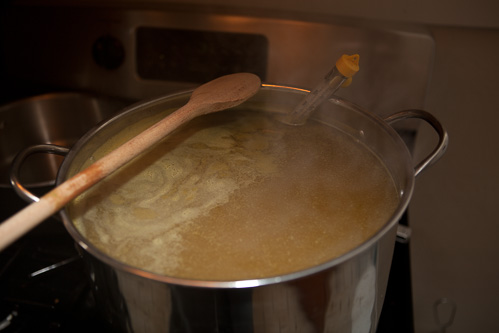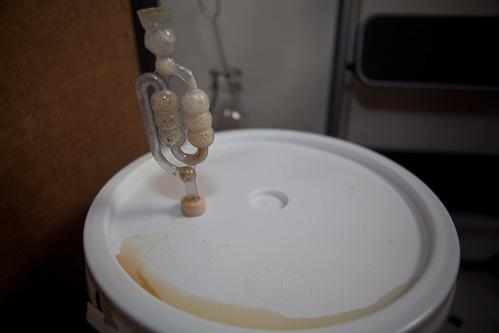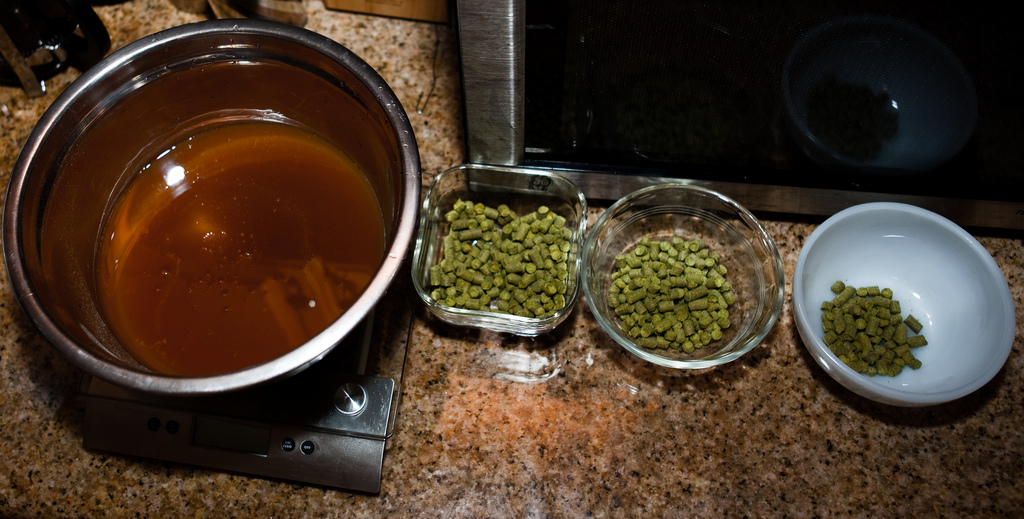So, technically, the brew was on the day after Valentine’s Day (or as it is affectionately known around the house since it coincides with the Chinese New Year, Loony FatChoyintine’s Day). The ingredients were sourced on the most special of holidays, though.
Bell’s Two Hearted Ale is an IPA brewed by Bell’s out of Kalamazoo, Michigan. Unfortunately, it isn’t available on the west coast. My first introduction to it was through a visit to the Patton Alley Pub during my vacation back home in Springfield, Missouri. It’s a straightforward dry-hopped IPA brewed with all Centennial hops. Having enjoyed my sampling and not having any access to it back home, I decided to attempt a clone. After a quick bit of Google research, I had a base extract recipe and shopping list.
Ingredients Shortlist
- 6# Extra Light DME
- 12oz. Wheat DME
- 8oz. Aromatic Malt
- 8oz. Crystal 10L Malt
- 3.5oz. Centennial 10% AAU
- WLP001 Ale Yeast
- Whirlfloc Tablet
Hop Schedule
- 1.5oz. @ 60 minutes
- 0.5oz. @ 15 minutes
- 1.0oz. @ 5 minutes
- 0.5oz. Dry Hop @ 6 days in secondary for 7 days
The clerk at my LHBS recommended sticking with a cheaper single liquid extract instead of two different more expensive dry malt extracts. Taking his advice, I replaced the six pounds and twelve ounces of dry extract with eight pounds of pale liquid malt extract. According to BeerSmith’s calculations, this seems to produce a slightly darker, lower A.B.V, and more bitter beer. The difference does not seem to be significant, though. There is a bigger difference in stats due to using the late extract addition method. Less extract at the beginning of the boil means increased hops utilization and a higher final IBU.
Vital Stats
- Target OG w/ LME : 1.063
- Target OG w/ DME: 1.064
- Target FG: 1.014
- IBU w/ LME: 76.7
- IBU w/ LME w/o LEA: 50.9
- IBU w/ DME: 72.8
- SRM w/ LME: 10.2
- SRM w/ DME: 6.4
- Expected ABV w/ LME: 6.35%
- Expected ABV w/ DME: 6.51%
- Actual Measured Session OG: 1.060
Session Recipe Summary
- 6 quarts water @ 158 degrees
- 4 quarts water boiled, cooled and set aside in primary
- 8oz. Aromatic Malt +
- 8oz. Crystal 10L Malt @ 155 degrees for 30 minutes
- 12 quarts water @ boil
- 2# Pale LME @ 60 minutes
- 1.5oz. Centennial Pellet Hops 9% AAU @ 60 minutes
- 6# Pale LME @ 15 minutes
- 1 Whirlfloc tablet @ 15 minutes
- 0.5oz. Centennial Pellet Hops 9% AAU @ 15 minutes
- 1.0oz. Centennial Pellet Hops 9% AAU @ 5 minutes
- 1 WLP001 Ale yeast
- 0.5oz. Centennial Pellet Hops 9% AAU @ Dry Hop 7 days in Secondary
The brewing session went along fairly smoothly and without any major hiccups. The process started with boiling and then cooling an extra gallon of water that would complete the partial boil when mixed with the wort in the primary fermenter. At the same time another gallon and a half of water was heated up to 158 degrees. Once heated, the pound of milled malt grains, combined in a grain bag was steeped for thirty minutes. This rest period presented a good opportunity to sanitize all of the remaining equipment and get the various ingredients measured out in the appropriate timed addition quantities.
The session picked back up with the main boiling period. I’d decided to continue to use late extract addition with a small amount of extract added at the start and the bulk of the remainder near the end. So there were two extract additions and three hop additions along with the clarifier tablet before flameout. The kettle then went into the ice water bath in the sink to cool down below 80 degrees. Once cool, it was mixed with the remaining water in the primary fermenter and the yeast pitched. The last step was sealing it all up with the lid, stopper, and sanitized airlock.

Fast forward twelve hours later to the next morning and there was still virtually no airlock activity. Was the wort hotter than I thought? Had I not aerated it enough? Would I need to go back to the store for more yeast and repitch? I gave it a bit more time and worrying about and by mid-afternoon, the little brewing droid finally began to show signs of life with it’s dutiful bloops and gargles. Within around 36 hours after pitching, yeast activity had kicked into high gear, pushing foam and solid material up into the airlock. Not wanting to switch my worrying over to a clogged airlock and a huge mess, I swapped it out with a sanitized blow off tube and run off bucket.
There are still a few areas in my process that need improvement. I forgot to take a hydrometer reading until almost an hour after I pitched the yeast. This should have been done right before pitching. Also, I might have been able to aerate the wort a bit more by pouring the first batch of water in the primary fermenter a bit more. I don’t think I’m getting very good conversion of my steeped grains. The slightly lower than expected O.G. reading seems to suggest this. I didn’t cover the kettle during the steep so I probably lost a lot more temperature over the course of the half hour than I should have. I also should have rinsed the grains with hot water at the end in order to extract more wort goodness from them.

One of the things I learned coming from the Porter session was how to better handle adding the malt extract. During that boil, the extract hit the bottom of the kettle and scorched and burned. This time, during each extract addition I turned off the heat and then mixed a bit of the hot liquid into the extract before adding it into the kettle. (You could think of this sort of like tempering an egg mixture when making a custard or some egg based sauce.) When working with liquid extract, this loosens it up and makes it easier to mix in. Plus, you can get all of it in the kettle without leaving a thick layer stuck in your measuring container.
All in all, it was a positive session. I’m continuing to learn new stuff every time and still have fun in the process. I’m looking forward to the dry hopping procedure after I rack to secondary next – and of course to tasting the final product in the end. This will also be the first batch that I keg. That’s the subject of another upcoming post…
Addendum
S.G. at the time of racking to secondary was at 1.015 for an A.B.V. of 5.74%. Everything looked good and I tossed the half ounce of pellet hops directly into carboy right before sealing it up with the airlock assembly. Airlock activity is down to one or two bloop per minute now.
